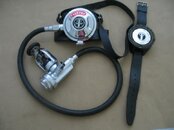You are using an out of date browser. It may not display this or other websites correctly.
You should upgrade or use an alternative browser.
You should upgrade or use an alternative browser.
what model is this
- Thread starter c5diver
- Start date
Please register or login
Welcome to ScubaBoard, the world's largest scuba diving community. Registration is not required to read the forums, but we encourage you to join. Joining has its benefits and enables you to participate in the discussions.
Benefits of registering include
- Ability to post and comment on topics and discussions.
- A Free photo gallery to share your dive photos with the world.
- You can make this box go away
divinginn
Contributor
US Divers Calypso,I had the same reg when I first started out. It has a pressure gauge built into the first stage,only reg I have ever seen with one.
It's late 60's.
You probably won't find a shop willing to service it.
There is a stem pressure gauge that pops out when pressurized rather like a tyre pressure gauge.
You probably won't find a shop willing to service it.
There is a stem pressure gauge that pops out when pressurized rather like a tyre pressure gauge.
That is a second generation Calypso. The first stage is the same but the second stage is different than the first generation. That model -second gen- first showed up in the 1965 catalog and the last year was 69. The first gen was from 61 to 64. Parts for the first stage are pretty hard to find...actually the HP seat is hard to find, the rest of the parts are common but I doubt you will find a dive shop willing to service it. The second stage is a different matter, it can be serviced with common parts and the main diaphgram is the same as a Conshelf. Odds are if you dissamble, clean, replace the orings and diaphgram and lube it back up it will work nicely. That reg has the distinction of being the first balanced first stage on the market.
The pressure guage is the small appendage by the yoke. If you look closely you will see a pin that is retracted, when you pressurize the reg, the pin extends out, how far depends on tank pressure....not exactly an ideal guage but a gauge none the less. Remember that SPGs were not common when this reg was introduced and J valves were commonly used. This gauge was intended to be used at the start of the dive to determine aprox how much pressure was in the tank, not as something to monitor like todays SPGs. If the pin was fully extended, you had a full tank and you dove until you needed to pull the J valve. The port is a standard (old style HP) 3/8x24 so you can remove the pin gauge and replace it with a SPG. That was an option in the day.
The pressure guage is the small appendage by the yoke. If you look closely you will see a pin that is retracted, when you pressurize the reg, the pin extends out, how far depends on tank pressure....not exactly an ideal guage but a gauge none the less. Remember that SPGs were not common when this reg was introduced and J valves were commonly used. This gauge was intended to be used at the start of the dive to determine aprox how much pressure was in the tank, not as something to monitor like todays SPGs. If the pin was fully extended, you had a full tank and you dove until you needed to pull the J valve. The port is a standard (old style HP) 3/8x24 so you can remove the pin gauge and replace it with a SPG. That was an option in the day.
- Messages
- 22,171
- Reaction score
- 2,803
- # of dives
- 5000 - ∞
If you need to outsource service, try: Professional Scuba Repair
ScubaPro had a similar device on some of their tank valves.

Forgot to add, the capillary depth gauge is easy to restore if the tubing is too cloudy to work. Once calibrated, they are very accurate at shallow depths. I often have a cap gauge along with me, neat piece of old gear to show students.
- Messages
- 22,171
- Reaction score
- 2,803
- # of dives
- 5000 - ∞
Until the advent of digital gauges capillary gauges were the best way to measure your depth for stops.
Similar threads
- Replies
- 1
- Views
- 227
- Replies
- 2
- Views
- 380




